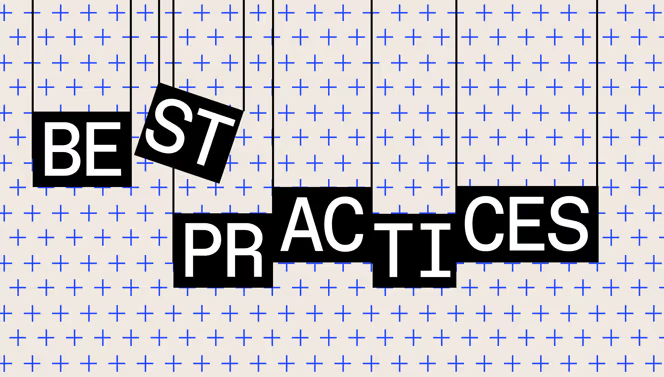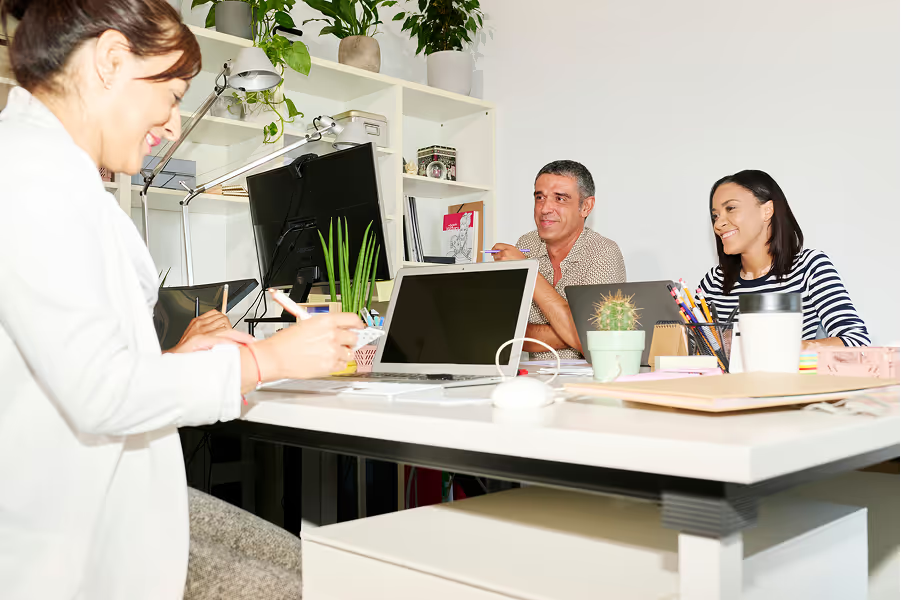11 Performance management best practices to drive organizational success

Discover Workleap Officevibe's benchmark report on 12 key employee engagement metrics

Performance management; if those two words send your gut plummeting to your toes, you’ll be happy to hear it’s evolved. Gone are the days of dreaded yearly reviews and performance appraisals. Instead, we have performance management 2.0, a version less concerned with what employees did wrong all year and more focused on actively helping them improve their skills and performance.
In this article, we'll dive into how techniques like goal alignment, frequent feedback, and meaningful recognition can drive employee, team, and organizational success — transforming you into the performance management maestro you were born to be.
{emphasize}Try our performance management best practices for thriving teams and organization
- What is performance management?
- Why is performance management important?
- Top performance management best practices
- How performance management software can help teams and companies thrive
- Build a modern performance management process to increase employee engagement and productivity{emphasize}
What is performance management?
Today's performance management is founded on continuous, honest conversations with employees about how they're doing in their jobs and where they could improve. Approaching these chats in a structured way by setting clear, realistic, time-bound goals ensures that you and your team members are on the same page about what’s expected and when.
Of course, managing employee performance requires continually monitoring their progress. Online solutions such as Officevibe’s performance management tool can help you effortlessly stay on top of your employee’s progress — facilitating continuous conversations, providing collaborative structures for employee goal-setting, and giving you a birds-eye view of everything your team has accomplished, what still needs to be done, and which red flags to address before they become bigger issues.
Why is performance management important?
Effective performance management acts like a traffic control system for managers and employees, ensuring a smooth flow of work within an organization. It helps identify bottlenecks, redirect resources, and find alternative routes to overcome challenges — paving the way for better team alignment and improved individual and company performance.
What’s more, an effective performance management system leads to:
- Increased goal alignment: Laying out individual and company objectives creates alignment throughout an organization and ensures that the whole team is working independently and together to attain these goals.
- Boosted employee engagement and productivity: An effective performance management strategy empowers employees by including them in goal-setting and decision-making processes. This gives them a sense of purpose that boosts engagement, satisfaction, employee retention, and team productivity.
- Better managerial leadership: Consistent feedback and guidance provided through a good performance management system sharpen both your coaching abilities and your employees’ skill sets. Strong managerial skills also contribute to better relationships which, in turn, lead to higher employee commitment and performance.
- Improved talent retention: Companies in which employees receive frequent feedback and constant communications with their managers have 14.9% lower turnover rates. Regular, meaningful feedback shows you care and can truly help retain your employees.
- Heightened organizational performance: Helping your employees learn, grow, and develop can have a significantly positive effect on a company’s overall performance, leading to higher revenue growth and improved customer satisfaction.
Top performance management best practices
“Ok,” we hear you say, “I’m sold. Performance management is the new black. So how do I go about implementing it most effectively?” Well, we’ve put together a list of 11 tried-and-true performance management best practices to drive high-performing employees and a thriving organization.
1. Make performance management agile and continuous
When it comes to driving continuous performance improvement, the importance of frequent check-ins can’t be overstated. That’s because routine one-on-one meetings invite a sense of familiarity and support that can only be achieved through regular informal discussions.
What’s more, they help managers and employees keep up to date on progress, address challenges, ensure alignment with goals and expectations, and provide a space for more open, focused conversations — basically, everything that helps develop an individual’s skill sets and nurture a sense of fulfillment.
2. Define clear roles and responsibilities
Your employees can’t read your mind. So, clarifying roles and responsibilities from the get-go is crucial to avoid confusion and frustration, and drive productivity, accountability, and a positive work environment. Clear roles and responsibilities also provide employees with a firm understanding of what’s expected of them, allowing them to focus their efforts on their tasks and goals and contribute to the organization’s overall success.
3. Set measurable goals together with your employees
While some employees need the occasional nudge, more often than not, they’re aware of what can realistically be achieved and what’s unfeasible. Roping them in on your goal-setting sessions can end up saving time and disappointment all-round — and it can make your employees feel heard and included, upping their job satisfaction and productivity.
Here are a few ways you can include your team members when establishing measurable goals:
1. Nurture your employees’ unique impact
Lay out your company's key business objectives for the next six months, then ask your employees how their skills and interests can help achieve these goals. While you can highlight the overall objectives, consider letting them set their own interim targets and encourage them to log their progress to ensure they’re on the right track.
2. Rebrand goal-setting
By simply renaming “goal setting” to "expectation setting," you can shift the focus from single-mindedly pushing to meet specific performance targets to the journey itself. Goals often change throughout the year, particularly in younger companies, so concentrating on the expectations of the team, the organization, and the employee can provide the flexibility you need to meet moving targets while cultivating a culture of engagement, alignment, and satisfaction.
3. Flame your employees’ passions
Up to 87.7% of the US workforce is underperforming due to a lack of passion for their work. You can help close this gap by encouraging your team members to set aside time each week to complete an online course or meet with a mentor in pursuit of their individual professional development goals.
🔥 Want to (re)ignite the spark? Discover the secrets to cultivating a passionate workforce.
4. Give your employees a helping hand
Working with employees to break up goals into bite-sized achievements (and then celebrating each milestone met) makes targets more achievable. Even if the entire goal remains unrealized, meeting interim targets gives employees the sense that they’re moving forward, meaning they’re less likely to become demotivated and stagnate.
Tip: Instead of adding an unachieved goal to next year's to-do list, try to get to the bottom of why it wasn’t met and how it can be adapted to make it more realistic.
[ov_cta id="5122598"]
4. Align employee, team, and organizational goals
Magic can happen when goals align. Involve employees by inviting them to share their unique untapped or developing skills, then set up a brainstorming session to figure out how these skills can be nurtured and used in a way that benefits them, their team, and their company.
Helping your team members see how their strengths can contribute to overarching company objectives will make them feel like they’re part of something bigger, leading to increased employee engagement, motivation, and confidence. It could even add a whole new angle to your organization.
📐 Looking to elevate alignment on your team? With Officevibe's goals and OKR tool, your employees can seamlessly set and track their individual objectives, ensuring they're always aligned with team and company-wide goals.
5. Give constructive and actionable feedback in real-time
According to a study conducted by Gallup, only 14% of employees strongly agree that their performance reviews inspire them to improve. This could be because traditional performance reviews alone aren’t exactly inspirational. Worse, relying on annual reviews that concentrate more on past performance failures as opposed to proactively addressing areas for improvement can result in missed opportunities for growth, decreased productivity, and disengaged employees.
Instead, focusing on providing timely, continuous, constructive feedback can empower your employees to make immediate adjustments, develop new skills, and improve their performance, fostering a more positive work environment.
Help your employees stay on track, maintain focus, and deliver high-quality work within shorter time frames by providing continuous, real-time feedback.
6. Address poor employee performance promptly
Your parents might have emphasized the adage "If you can't say something nice, don't say anything at all," but chances are they weren't thinking about your company’s performance management practices.
While it might not be comfortable, addressing poor performance promptly is crucial to preventing bigger problems and potentially more difficult conversations down the line. In fact, pulling off the band-aid at the right time could actually drive organizational growth and lead to improved employee morale and increased accountability. According to a study by Zenger and Folkman, 92% of employees agree that negative feedback delivered appropriately is effective at improving performance.
🧭 Learn to navigate challenging conversations like a pro with our guide to tackling tough talks.
7. Provide frequent and meaningful recognition
Giving your employees frequent and meaningful recognition empowers them to achieve professional growth and enhances their engagement. It also makes them feel seen and valued, which encourages them to go above and beyond, creating a thriving work environment.
Need some tips on how to make your team feel valued? See our guide to creating a culture of workplace recognition.
8. Build trusted relationships with your employees
Trust and respect are two-way streets. And they’re imperative to a healthy working relationship that fosters employee engagement, satisfaction, retention, and improved performance.
Here are some key practices to help build trust with your team:
- Communicate effectively: Providing regular, clear, and transparent updates on company changes, challenges, and organizational goals will ensure everyone feels informed and involved. To up your two-way communication, encourage reciprocal feedback, suggestions, and open discussions.
- Delegate and empower: Delegating meaningful responsibilities to your employees empowers them to make decisions and take ownership of their work — and employees who feel trusted to do their best are more confident and motivated to excel.
- Support professional growth: Show your team you believe in them by demonstrating a genuine interest in their aspirations and helping them acquire new skills and knowledge through training, workshops, and mentorship programs.
- Show recognition and appreciation: Demonstrating genuine gratitude for your employees' hard work lets them know that their efforts matter and fosters a positive and supportive environment.
- Support work-life balance: Encouraging a healthy work-life balance lets employees know you prioritize their well-being. You can improve your employee experience by offering perks like remote work options and flexible schedules.
9. Implement a fair performance review process
Biases are baked into our subconscious, so getting around them can be tricky. But it’s important to try, as an unobjective evaluation can undermine the credibility of your entire review process.
Since biases are inherently human phenomena, employing performance review software that can objectively evaluate employee performance is key. Such a tool enables managers to deliver a fair and balanced review that encourages deep growth and development, mitigates legal and ethical risks, and fosters a greater sense of trust and credibility within your organization.
Stuck for inspiration? See our blog to get insights on how to create a bias-free, effective, and positive performance review framework.
10. Act like a coach, not a boss
Traditionally, a boss is associated with control, task completion, and hierarchy, while a coach prioritizes learning, growth, collaboration, and empowerment. So by coaching your employee, you can build stronger, more grounded relationships with your people.
As a bonus, you’ll also enhance autonomy and employee engagement, while creating a supportive and developmental work environment.
11. Coach, train, and evaluate managers as much as employees
It’s not just employees who need coaching and evaluation. Developing managers alongside employees helps build strong leadership teams that drive success at all levels. Coaching, training, and evaluating managers creates a strong pipeline of capable leaders.
Additionally, by aligning their actions and behaviors with the company’s culture, you’ll be promoting cohesiveness, clarity, and alignment throughout the organization.
How performance management software can help teams and companies thrive
You want to be the best leader you can be. You also only have so many hours in a day. Fortunately, there are software tools that can help streamline your performance management processes. Here’s how:
- One-on-one meetings: Find a solution that has a dedicated feature for facilitating regular manager-employee dialogues. Officevibe’s simple one-on-one meeting software provides an easily navigable way to schedule meetings, set agendas, capture meeting notes, and track progress, which promotes regular, meaningful communication and strengthens manager-employee relationships.
- Performance reviews: Performance reviews need not be big, scary annual documents. Employing a feature like data-driven performance reviews can help you track your employees’ progress, continually evaluate their performance, and share your insights with them in real time. This helps keep everyone on track as to what’s expected of them and what needs to be changed to reach peak employee performance.
- Goals and OKRs: The goals and Objectives Key Results (OKRs) feature of Officevibe lets you and your team members define and align individual, team, and organizational objectives. It also helps keep your finger on the pulse of the progress they’re making to achieve goals, promoting transparency, clarity, accountability, and focus.
- Recognition: Recognition boosts morale and creates a positive work environment. But you might not know exactly when, where, and how to show gratitude to your employees. To hit the right note 100% of the time, try Good Vibes, a recognition feature that enables manager-to-employee and peer-to-peer appreciation and recognition.
- Feedback: Delivering ongoing feedback and communication sounds exhausting, but it's a vital part of the performance management process. Luckily, employee engagement features offer a simple, fuss-free way of understanding your employees, identifying where they’re struggling and what makes them happy, and reaching out to address any disengagement signs.
Build a modern performance management process to increase employee engagement and productivity
The evolution of performance management has seen it morph from static yearly reviews to a continuous process focused on employee improvement. To foster this kind of positive work environment, you can implement performance management best practices like goal alignment, clear goal-setting, trust building, genuine recognition, and frequent and timely feedback.
Of course, all this requires the continuous tracking of employee performance, processes, and milestones, which can be easily facilitated through performance management software that provides essential features such as goal tracking, performance evaluations, one-on-one meetings, and the promotion of effective communication and collaboration.
By leveraging these tools like a boss (or a coach!), you can streamline your future performance management models and make better-informed decisions to support your teams and organizations.
Give HR and managers the clarity, confidence, and connection to lead better every day.


%20(1).avif)


.avif)
.avif)








